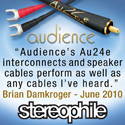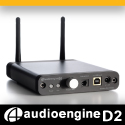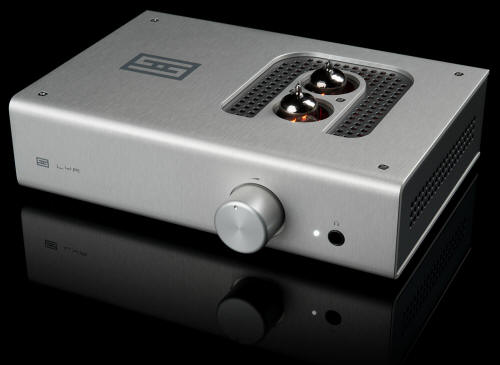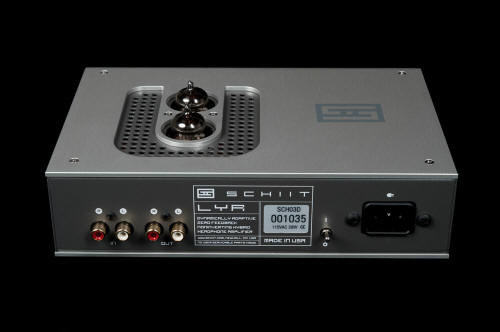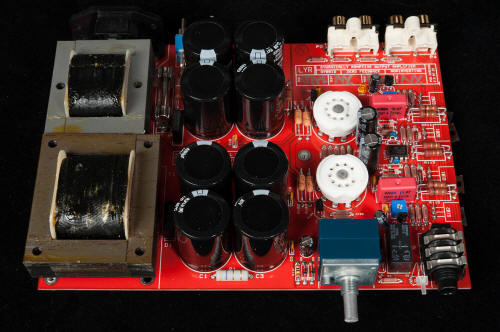|
|
You are reading the older HTML site
Positive Feedback ISSUE 62
schiit audio Lyr Headphone Amplifier as reviewed by John Acton
In their pursuit of perfection without sacrifice or compromise, high-end audio manufacturers tend to take themselves too seriously. With ornate and inert casework that requires professional movers to install, boutique electronic parts that are discontinued after their initial production run, marketing material that is as intimidating as it is avarice-inducing and price tags that exclude all but the wealthiest of customers, it's no wonder that non-audiophiles have a difficult time coming to grips with the hobby. In seeming cognizance of the industry's hubris, and in direct contradiction of the same, along comes Schiit Audio. First, there's the name. And, yes—Schiit is pronounced exactly as it reads. Secondly, there's the product focus; rather than coming out of the gate with no-holds-barred assaults on the state of the art, Schiit Audio's initial offerings comprise a line of headphone amplifiers and DACs that rely on tried-and-true technologies. Thirdly, there's the pricing model; even by non-audiophile standards, the pricing of Schiit's products are reasonable, and in comparison to high-end prices, Schiit's have to be seen as bargain-basement. Just because Schiit Audio doesn't take itself seriously as a company doesn't mean that it isn't serious about audio reproduction. Schiit's founders, Mike Moffat and Jason Stoddard, have a long and storied history in the high-end industry. Moffat worked at Theta, and during his tenure there, designed the Theta preamplifier, after which he moved over to Theta Digital, where he designed the DS Pre and DS Pro. Stoddard worked at Sumo, where he designed numerous products, including the Polaris II, Amdromeda II, Ulysses, and Diana. The Lyr represents the top-of-the-line headphone amplifier in Schiit's current line-up, and like all Schiit products, owes its name to Norse mythology. Whereas the Asgard headphone amplifier is completely solid-state and the Valhalla is fully tube-based, the Lyr is hybrid, combining a tube input / driver stage with a solid-state output stage. Where the Lyr distinguishes itself from its stable mates is in its sheer power output and concomitant ability to drive any headphone, even notoriously hard-to-drive orthodynamics like HiFiMan's HE-6.
Externally, Schiit's Lyr is compact, measuring 9" wide by 6.75" deep by 3.25" tall and weighing 7 pounds. Its feature set is minimalist, with a volume control and 1/4" headphone jack on the front and RCA inputs, variable preamp RCA outputs and IEC AC inlet on the rear. The Lyr can accommodate exactly one source. Powering on the Lyr is accomplished via a toggle switch on the rear panel. All connections and controls are of high quality, and the overall build is reassuringly solid. The case is attractively styled and finished in silver, with the two recessed input tubes rising a half-inch or so above the top chassis. Internally, Schiit has packed a lot of technology into the Lyr, especially considering its low price. The circuit design is completely discrete in nature, replete with dual R-core transformers and high-quality parts sourced from respected companies such as Wima. The input stage employs two tubes, and Schiit can provide customers with their choice of new-production JJ ECC88 or 6N1P tubes, or NOS GE 6BZ7 tubes. My Lyr came with the GE 6BZ7 tubes. Schiit encourages users to experiment with tube rolling, and the Lyr will accommodate any 6922, ECC68, 6BZ7, 6N1P, 6DJ8, CV2492 or CV2493 type small-signal tube. The Lyr utilizes a solid-state, dynamically-adaptive output stage, whereby it runs in single-ended Class A at low levels, switching to push-pull Class A as current demands rise, and finally to push-pull class-AB at the highest current demands. This clever sliding-bias topology enables the Lyr to output 6 watts into a 32-ohm impedance, ensuring that it can drive even the most difficult headphone loads. Like all Schiit products, the Lyr is manufactured in the USA and comes with a five-year warranty. Tubes are warranted for a period of 90 days.
During the course of the review, I partnered the Schiit Lyr with the Sennheiser HD 800 and AKG K702 headphones, and briefly with some ancient Grado SR60 and Sennheiser HD 580 'phones. I did not have any orthodynamic headphones from Audeze or HiFiMan on-hand for evaluation purposes. My source was the Simaudio MOON CD5.3 cd player. Cabling included the Kimber Hero AG interconnect and Audience powerChord 'e' power cords, with power conditioning courtesy of the Audience aR2p-TO. The Lyr sat on Ayre Acoustics myrtle blocks, and the Solid Steel 8.2 Audio Table provided support for the entire system. Initial installation and setup of the Lyr is easy, and the accompanying user manual is thorough, well-written and humorous. The two tubes are safely ensconced in their own box inside the larger amplifier container, and everything is well-packed. To get up and running, the user simply has to insert the tubes into their sockets, hook up the interconnects and power cords, and plug in his or her headphones. A 20-second mute upon start-up prevents transients from reaching the headphones. Being heavily biased into Class-A, the Lyr runs warm and requires 30 – 60 minutes to fully stabilize after turn-on. The Lyr sounded fine right out of the box, but did open up over the course of the first 100 hours or so of playing time. The first thing that struck me when listening to the Lyr was the sense of inexhaustible headroom and effortlessness it conveyed. Schiit Audio is serious when cautioning against destroying one's headphones with indiscriminate turns of the volume knob. Tonally, the overall presentation was imbued with a sense of warmth and solidity, especially in the lower midrange and upper bass. This quality worked synergistically to flesh out the lower registers of the Sennheiser HD 800 and AKG K702 headphones, both of which are extremely accurate, and as a consequence can sound a touch threadbare depending on partnering ancillaries and/or source material. This was readily made apparent on "Ron Carter" from Bill Frisell's Blue Dream CD (Nonesuch 79615-2), where David Filtch's bass was rendered with augmented authority and weight. The Lyr's midrange was open and transparent, and possessed the merest hint of golden-hued liquidity, which served vocals especially well. Suzanne Vega's voice on "Caramel" from her Nine Objects of Desire release (A&M 5405832) was consummately reproduced, providing clear insight into the seduction and unrequited desire lurking behind the upbeat jazzy setting. And the Lyr ably laid bare Paul Simon's sardonic yet heartfelt ode to abandonment in "That's Why God Made the Movies" from his remastered One-Trick Pony CD (Warner Brothers R2 78902). Time Out (Columbia / Legacy CK122) by the Dave Brubeck Quartet is one of my favorite recordings. Despite how many times I've listened to it, I never tire of hearing it, and as much as I like Brubeck's exquisite piano playing and employment of unusual (for jazz) time signatures, I'm drawn more to Paul Desmond's exuberant alto sax. Listening to "Strange Meadow Lark," I was hypnotized once again, with the Lyr bringing out all of Desmond's nuanced and expansive soloing. The Lyr's treble was extended and grain-free, and provided an open window to what was present on the recording. And while I've heard amplifiers that reproduced the treble registers with greater air around instruments, the Lyr was certainly no slouch in that area. The Lyr did an excellent job with soundstaging. Listening to "The Price We Pay" from A Scarcity of Miracles (DGM 1101) by Jakszyk, Fripp and Collins via the Lyr and Sennheiser HD 800s, the band was spread out in an arc around my head, with Jakszyk's vocal, Collins' saxophone and Fripp's sampled Mellotron washes floating just in front of my forehead. The Schiit amplifier also performed admirably with respect to imaging, precisely placing each performer in his/her own space on the stage. St. Vincent's most recent release, Strange Mercy (4AD CAD3123CD), has a lot going on in most songs, and Annie Clark clearly does not shy away from multi-track mixing. On "Northern Lights," I was impressed with the Lyr's ability to delineate Billy Sparks' frenetic Minimoog synth work from Clark's guitar playing, and to juxtapose that against a swirling menagerie of drums, noise, samples and supplemental keyboards. So, were there any negatives to Schiit Lyr? Sonically, I could find very little to fault, and my only criticism regarding the slight lack of air in the treble region could very well be ameliorated via judicious rolling of the Lyr's tubes. Operationally, the Lyr proved itself extremely easy to use and never evinced any aberrant behavior. If there is one thing I could have wished for, it would have been a way to adjust the amplifier's gain. Being a low-volume listener, I found that I couldn't advance the volume past 9:00, beyond which things became uncomfortably loud very quickly. From a comparison standpoint, the closest competitor to the Lyr I had available was the Lehmann Audio Black Cube Linear headphone amplifier. The Black Cube Linear is manufactured in Germany and retails for $1149 in the US. Like the Lyr, the Black Cube Linear is biased to run in Class-A and has a fully discrete output stage. Unlike the Lyr, the Black Cube Linear is completely solid-state (its input stage is op-amp-based) and has adjustable gain. The two amps sounded similar in the midrange, both rendering vocals with superb openness and transparency. The Lyr, however, added a hint of body to the lower midrange, and continuing lower, warmed up the upper bass; in contrast, the Black Cube Linear was leaner, with a more analytical sound. While both amps were extended and grit-free in the treble, the Black Cube Linear presented more air around instruments. The Lyr pulled ahead with respect to imaging and soundstaging, sounding a tad more dimensional in comparison to the flatter perspective of the Black Cube Linear. Schiit Audio clearly has a winner with the Lyr headphone amplifier. I frankly had no reason to expect that such an inexpensive component (manufactured in the US, no less) could sound as good as it does. Coupled with great customer support, a full five-year warranty and endless opportunity to tailor its sound via tube rolling, the Lyr represents a flat-out bargain, one that will keep owners happy for years to come. John Acton
Lyr Headphone Amplifier
Schiit Audio
|
